The Big Read: A hundred days in, worries in Asia over Trump ease
SINGAPORE — When Donald Trump was elected president of the United States, anxiety within Asia spiked to new levels on the back of his campaign rhetoric, which suggested an America that would turn its back on much of the rest of the world.
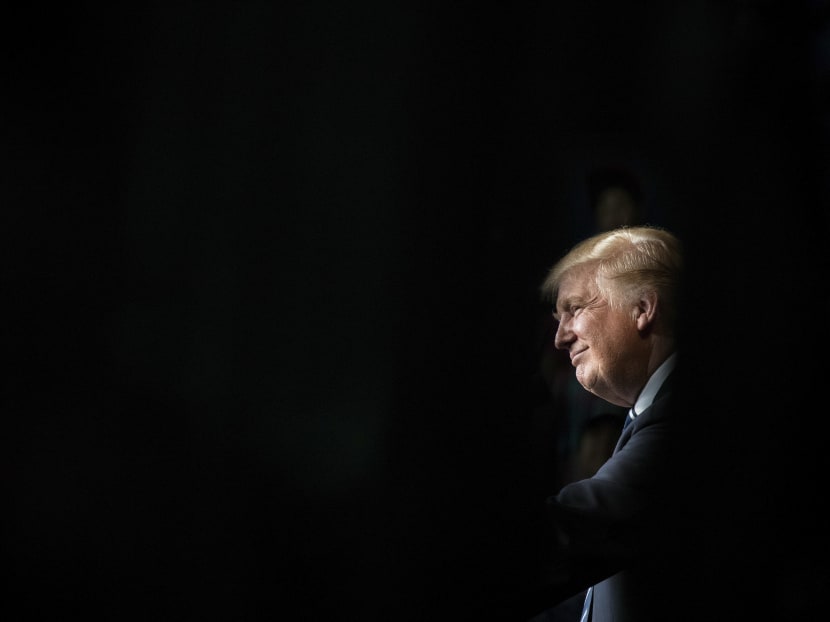
Then candidate Donald Trump smiles as the crowd chants "President Trump" during a campaign rally at the W.L. Zorn Arena in Eau Claire, Wis., Nov. 1 2016. Photo: New York Times
SINGAPORE — When Donald Trump was elected president of the United States, anxiety within Asia spiked to new levels on the back of his campaign rhetoric, which suggested an America that would turn its back on much of the rest of the world.
The unease was felt in Singapore too, and leaders from Prime Minister Lee Hsien Loong down warned that the Republic and the Asia Pacific would have much to lose.
After Mr Trump’s first 100 days in office – a threshold that falls on April 29 – however, much of that anxiety has been calmed, if not dissipated entirely.
As Professor Chan Heng Chee, who was Singapore’s Ambassador to the US between 1996 and 2012, told TODAY, it has been “so far so good” for Asia under the Trump presidency.
Veteran diplomat Ong Keng Yong summed it as follows: “If I were to grade the Trump administration for its Asia policy to date, it would be ‘A’ for talking tough, ‘B’ for being flexible, and ‘C’ for lacking strategic undergirding.”
The 100-day milestone used to assess American presidents traces its history back to President Franklin Roosevelt, who took office during the Great Depression and passed 15 major pieces of legislation in short order.
While there is no magic to the number 100, it is still a common benchmark seen as a new president’s first and perhaps best chance to reshape the nation according to his own agenda and vision.
During the past three months or so, Mr Trump did act on a number of the radical campaign promises he had made, with the most significant being withdrawing the US from the Trans-Pacific Partnership (TPP) trade pact.
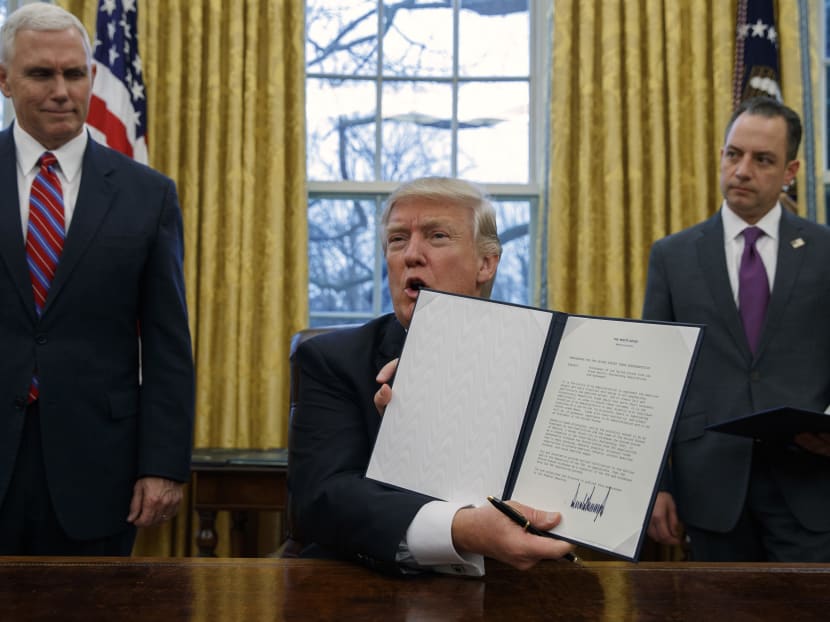
DAY 4 - In this Jan 23, 2017, file photo, US Vice President Mike Pence, left, and White House Chief of Staff Reince Priebus, right, watch as President Donald Trump shows off an executive order to withdraw the US from the 12-nation Trans-Pacific Partnership trade pact agreed to under the Obama administration in the Oval Office of the White House in Washington. Photo: AP
However, he also flip-flopped on a number of electoral pledges and reverted to traditional American positions, most notably those pertaining to China and North-east Asian allies Japan and South Korea, much to the relief of regional leaders and observers.
IMPLICATIONS FOR SOUTH-EAST ASIA AND SINGAPORE
South-east Asia has hardly been on the radar of the Trump administration, but experts say that this is par for the course in new US administrations.
Other than a two-day trip to Indonesia last week by Vice President Mike Pence, there has been no other high-level delegation from Washington to the region.
“The region has seldom been a priority for US presidents. While Mr Trump may find South-east Asia of some interest to him, it will not garner much attention given that it is relatively stable compared to North-east Asia and the Middle East,” said Prof Chan, who is Singapore’s Ambassador-at-Large.
Mr Joshua Kurlantzick of the US-based Council for Foreign Relations (CFR) noted that the amount of attention the previous Barack Obama government paid to the region was unprecedented, and that succeeding governments would be hard pressed to match this level of commitment.
“Obama was an outlier in relation to South-east Asia. Looking ahead, Trump is likely to revert to what had been mostly the norm for US policy in the 1990s and 2000s, which was to make the region a relatively low priority in US policy,” noted Mr Kurlantzick, who is a senior fellow with CFR.
Mr Obama was the first US president to elevate South-east Asia’s importance in Washington’s Asia policy. During his eight-year tenure, he travelled to the region seven times and met all the leaders of Association of Southeast Asian Nations (Asean).
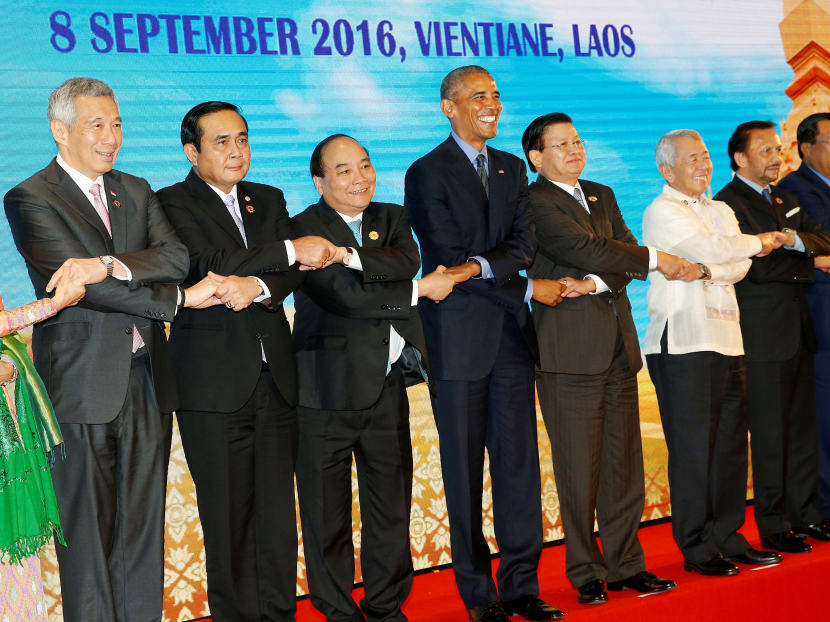
Myanmar's State Counsellor Aung San Suu Kyi (L-R), Singapore's Prime Minister Lee Hsien Loong, Thailand's Prime Minister General Prayuth Chano-cha, Vietnam's Prime Minister Nguyen Xuan Phuc, US President Barack Obama, Laos Prime Minister Thongloun Sisoulith, Philippines Foreign Affairs Secretary Perfecto Yasay, Brunei's Sultan Hassanal Bolkiah and Cambodia's Prime Minister Hun Sen join hands for a family photo before their US-ASEAN meeting as a part of the ASEAN Summit in Vientiane, Laos September 8, 2016. Photo: Reuters
And even though Mr Pence announced last week that Mr Trump would attend the US-Asean Summit and the East Asia Summit (EAS) in the Philippines as well as the Asia Pacific Economic Cooperation (Apec) Summit in Vietnam later this year, analysts said this does not automatically translate into a concerted effort to engage the region.
“The best we can conclude from this announcement is that Trump has finally noticed the region. I don’t know if we can say it has grown important to him,” explained Mr Harry Sa, a research analyst at the S Rajaratnam School of International Studies.
“Attending the Apec Summit and EAS is merely par for the course as a state leader, and it wouldn’t look great if Trump skipped these meetings while the leaders of other major powers were present,” he added. “The key question to ask would be – why has Mr Trump taken notice of South-east Asia only now?”
To be sure, the US has not completely ignored Asean, with US Secretary of State Rex Tillerson scheduled to host meetings for his counterparts from Asean in the US next week.
For Singapore, the initial months of the Trump administration have seen a continuation of high-level engagement.
Foreign Affairs Minister Vivian Balakrishnan and US National Security Adviser H R McMaster met in March, and affirmed the “robust and mutually beneficial” bilateral partnership between the two countries.
Earlier this month, Defence Minister Ng Eng Hen met with Pentagon chief James Mattis, where US-Singapore ties were similarly reaffirmed.
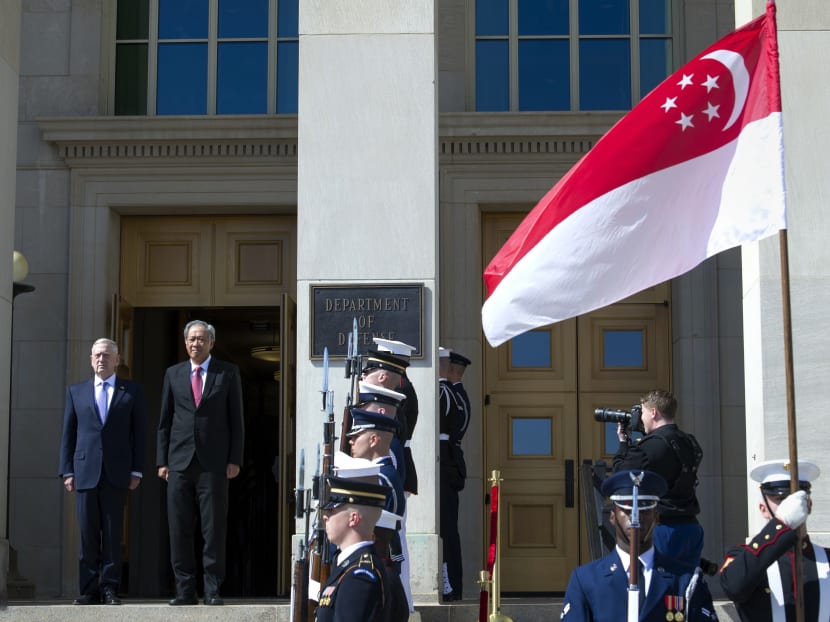
US Secretary of Defence Jim Mattis welcomes Singapore's Defence Minister Ng Eng Hen to the Pentagon for meetings, Wednesday, April 5, 2017. Photo: AP
Six F-15SG jets of the Republic of Singapore Air Force (RSAF) and about 100 personnel are currently deployed to an air base in Guam in the Western Pacific for a month-long training with the American military.
During a visit to the White House at the invitation of Mr Obama last year, Mr Lee had said that the Government was exploring the possibility of RSAF training in Guam.
Last week, Deputy Prime Minister Teo Chee Hean also made an official trip to the US, where among other things, he visited the RSAF’s training detachment at Luke Air Force Base in Arizona.
On the economic front, all is not gloomy as well for Singapore as originally thought.
Despite America’s withdrawal from the 12-member TPP, Japan is ready to relaunch the trade pact in a dramatic shift of position that could bring the huge trade deal back from the dead. Singapore, a key proponent of the TPP, has previously indicated that it will continue its preparations to ratify the trade pact, pending discussions with the remaining partners.
When asked about how Singapore might view the Trump administration considering that it has shown both signs of engagement and disengagement with the region so far, Prof Chan said that it is “good policy” to give the new government more time to settle down.
Mr Ong, who is the executive deputy chairman at RSIS and a former Asean secretary-general, believes that Singapore can consolidate its relationship with the Trump administration.
“US foreign policy is broad-ranging, and many convoluted considerations are injected into the decision-making … Singapore should ensure that all aspects of this bilateral account are in good order and ready to move into an active mode when the White House desires to do so,” said Mr Ong.
“If Singapore remains nimble and keeps its relations with different parts of the Trump Administration up to date, we can strengthen our bilateral ties with Washington.”
IMPROVING TIES WITH CHINA

US President Donald Trump, right, shakes hands with Chinese President Xi Jinping during a dinner at Mar-a-Lago, Thursday, April 6, 2017, in Palm Beach, Florida. Photo: AP
During his campaign trail, Mr Trump repeatedly attacked China, calling it a currency manipulator. Some of those associated with his campaign also called for a harder line towards Beijing in reducing the US trade deficit with China, as well as upping US naval power in the region to contend with China’s maritime expansion.
In December last year – a month before he took office – Mr Trump infuriated China by speaking to Taiwanese President Tsai Ing-wen on the phone. Soon after the call, Mr Trump questioned the sanctity of America’s One China policy, prompting an angry response from Beijing, which said the One China principle was non-negotiable.
It was only in February that Mr Trump told President Xi Jinping in their first phone call that he would respect the 44 year-old One China policy, under which the US recognised a single Chinese government in Beijing and severed its diplomatic ties with Taiwan.
Since then, the Trump administration has adopted a more conciliatory stance towards China.
During Mr Tillerson’s visit to Beijing in March, he called for bilateral ties to be based on “non-confrontation, no conflict, mutual respect and win-win cooperation”.
This set the tone for a highly anticipated summit between Mr Trump and Mr Xi earlier this month, with Mr Trump hailing the bilateral relationship as “tremendous”.
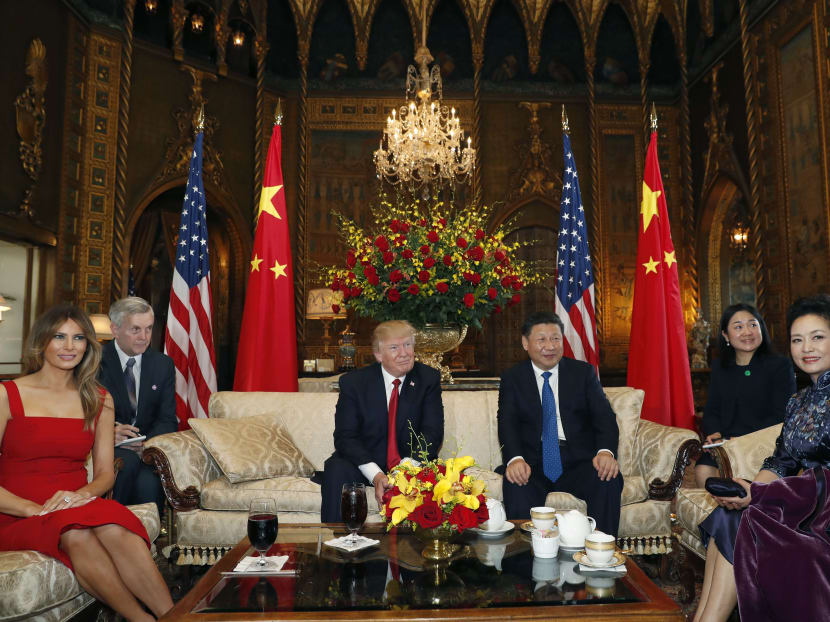
US President Donald Trump and Chinese President Xi Jinping, sit with their wives, first lady Melania Trump, left, and Chinese first lady Peng Liyuan, right, before a meeting at Mar-a-Lago, Thursday, April 6, 2017, in Palm Beach, Fla. Photo: AP
Experts told TODAY that this about turn in America’s China policy points to the presence of two camps within the Trump administration.
“There is a camp that is highly wary of China and another which advocates a more ‘traditional’ China policy,” said Dr Chong Ja Ian, a China observer with the National University of Singapore.
The anti-China camp counts among its ranks the likes of White House Chief Strategist Stephen Bannon and Commerce Secretary Wilbur Ross. The other camp, pushing for a more cooperative relationship, with Beijing includes the president’s Senior Adviser Jared Kushner, Treasury Secretary Steven Mnuchin and Mr Tillerson.
Forging a consistent China policy would not be easy given the tussle between these two camps. Mr Trump himself also seems to lack the interest or the ability to understand the details necessary for strong policy guidance, said Mr Carl Baker, a retired US Air Force officer who is now a programme director with the Washington-based Centre for Strategic and International Studies (CSIS).
“While it is not uncommon for new administrations to back away from hardline policy statements once they take office, I think the lack of coherence and the appointment of many individuals with limited experience in dealing with national-level issues exacerbated the problem,” Mr Baker added.
Going forward, there are signs that the Trump government is settling into a more pragmatic China policy as it recognises the benefits of cooperating with Beijing on various issues, especially trade and North Korea’s nuclear threat.
Earlier this month, Mr Trump reversed his campaign pledge to label China as a currency manipulator, citing the need to cooperate on the “bigger problem” that is North Korea.
In an interview this week, Mr Trump also rejected the suggestion by Taiwanese President Tsai Ing-Wen that she might speak directly again to the US President, saying that he has established a very good personal relationship with President Xi.
“I really feel that he is doing everything in his power to help us with a big situation,” Mr Trump said in reference to the North Korean issue.
“I think he’s doing an amazing job as a leader and I wouldn’t want to do anything that comes in the way of that. So I would certainly want to speak to him first,” Mr Trump added.
Still, analysts say it is premature to conclude that dark clouds over US-China relations are gone.
“While the future of Sino-US ties looks good for now, it is hard to say how long it will last. From their summit in Florida, Trump and Xi seem to have a good relationship, and this would be an important factor in shaping Sino-US ties in the future,” said Professor Zhang Baohui, who is with the Department of Political Science at Hong Kong’s Lingnan University. “However, should North Korea ratchet up its provocations, say, carry out another nuclear test, Trump will pressure Xi to do more, and this could trigger tensions between the US and China.”
Besides the thorny issue of North Korea, Beijing’s maritime ambitions could also strain ties between the two powers.
“Chinese assertiveness in the South China Sea and the East China Sea could test the relationship – for example, if Beijing starts (the) construction of a military facility at Scarborough Shoal in the Spratly Islands,” security expert Andrew Shearer told TODAY.
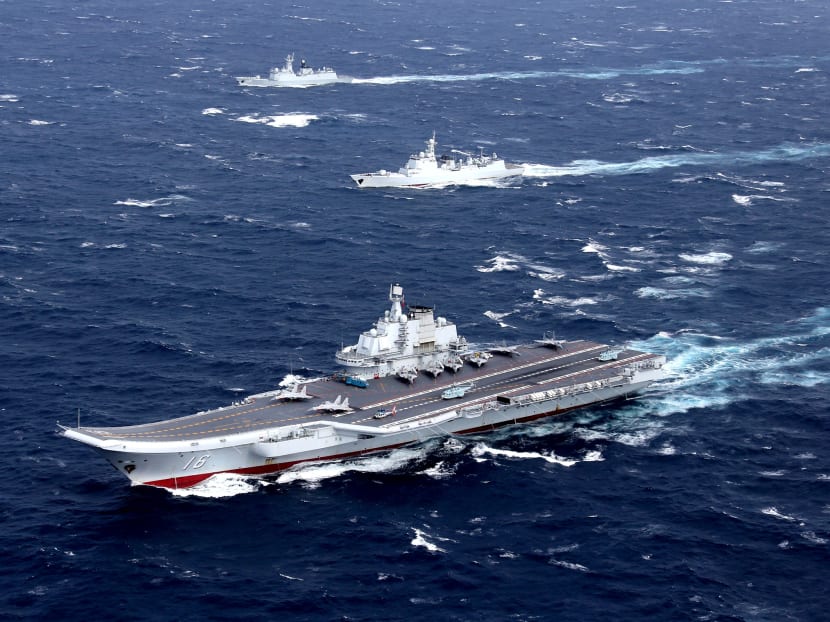
China's Liaoning aircraft carrier with accompanying fleet conducts a drill in an area of South China Sea, in this undated photo taken December, 2016. Photo via Reuters
Mr Shearer, who is CSIS’ senior adviser on Asia-Pacific security, also observed that notwithstanding Mr Trump reneging on his promise to label China as a currency manipulator, tensions over trade should not be ruled out given how highly it featured during Mr Trump’s electoral campaign.
COMMITMENT TO SECURITY ALLIANCES
Another issue Mr Trump had repeatedly raised on the campaign trail was the value of longstanding security alliances, including those in Asia.
The presence of US military forces in Asia has underpinned peace and prosperity for decades, and Mr Trump’s comments that Japan and South Korea should become nuclear powers as the US “cannot afford to be the military and the police for the world” caused much anxiety in the region.
He also repeated said that the two Asian allies should contribute more financially to their defence relationships with America.
But just two weeks after Mr Trump’s inauguration, Defence Secretary Mattis visited South Korea and Japan and assured them of America’s full commitment to their security.
Similar assurances were made in similar visits by Mr Tillerson a month later and by Mr Pence last week.
Mr Baker of CSIS said that Mr Trump clearly did not have a clear understanding of the importance of the alliances in US security policy before he took office.
“Specifically, I think there was a general lack of awareness of the amount of support South Korea and Japan provided to maintain US forces in North-east Asia,” said Mr Baker. “What has emerged in the early months of the administration is that the US has sought to correct this perception by reassuring its Asian allies with visits by both Defence Secretary Mattis and State Secretary Tillerson.”
Notably, Mr Trump had also signed off on a joint statement with Prime Minister Shinzo Abe reaffirming the US’ commitment to defend Japan through nuclear and conventional military capabilities during the Japanese leader’s visit to Washington in February.
Since then, the White House has deployed the nuclear-powered aircraft carrier USS Carl Vinson and the Terminal High Altitude Area Defence (Thaad) anti-missile system in the Korean Peninsula in response to Pyongyang’s nuclear and missile programme.
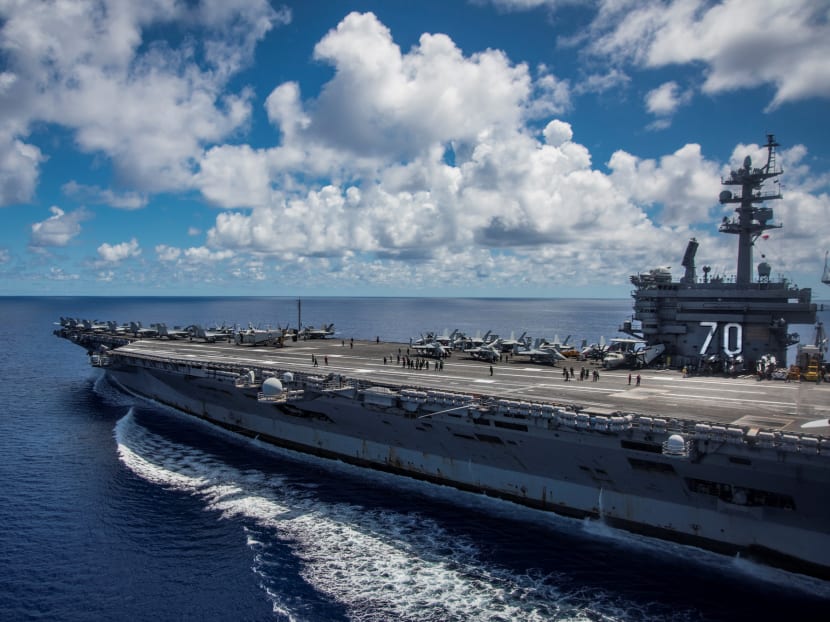
The Nimitz-class U.S. Navy aircraft carrier USS Carl Vinson transits the Philippine Sea while conducting a bilateral exercise with the Japan Maritime Self-Defense Force April 23, 2017. Photo: US Navy/Mass Communication Specialist 2nd Class Z.A. Landers/Handout via Reuters
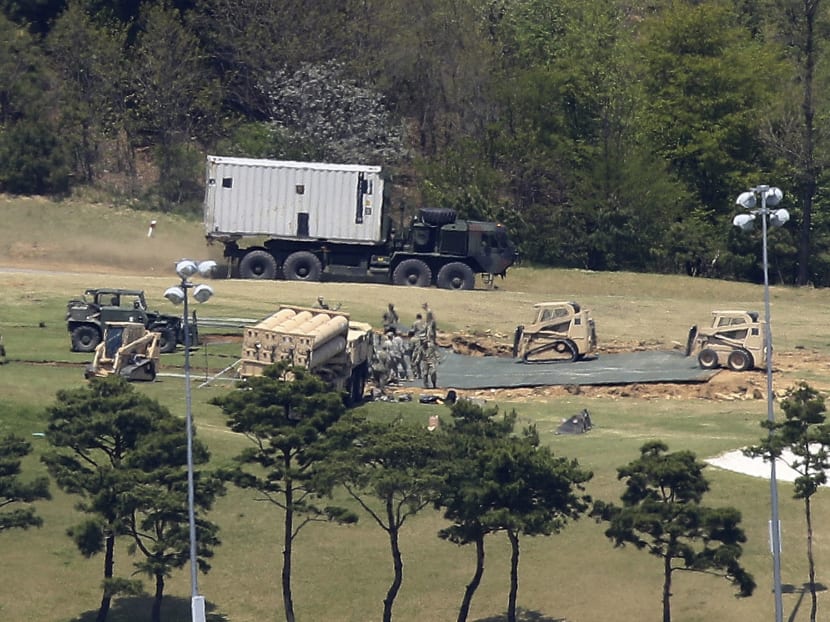
US Army soldiers install their missile defense system called Terminal High-Altitude Area Defense, or THAAD, at a golf course in Seongju, South Korea, Thursday, April 27, 2017. Photo: Shon Hyung-joo/Yonhap via AP
“The North-east Asia-US dynamic so far represents welcome continuity with post-war US grand strategy in Asia, which is based on longstanding American interests in the region, rising threats, and the strong alignment of values with US allies in the region,” said Mr Shearer.
“America’s major alliances in the region have strengthened in recent years irrespective of who is in office in Washington or (the) regional capitals,” he added.
“This trend is likely to continue as the balance of military and economic power shifts against the United States and its allies, and as the threats posed by North Korea’s nuclear and missile programmes and China’s rapid military modernisation advance.”
This being said, analysts believe that it would be early to make any firm assessment of the Trump government’s foreign policy based on its first 100 days in power.
The President’s unconventional leadership style and his track record of changing his positions on key issues also means that nothing should be taken for granted.
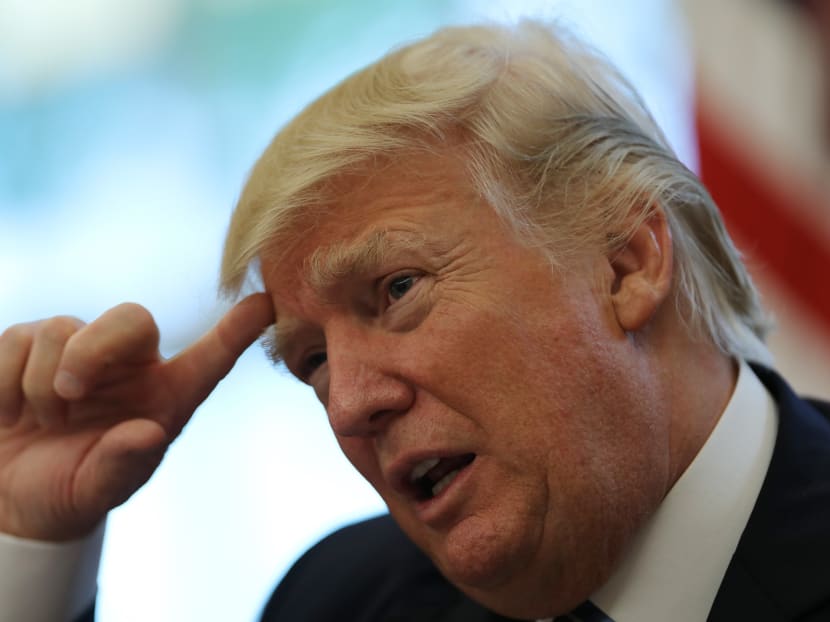
US President Donald Trump speaks during an interview with Reuters in the Oval Office of the White House in Washington, U.S., April 27, 2017. Photo: Reuters
While the fact that Mr Trump spoke on the phone with Mr Xi and Mr Abe on a number of occasions on the North Korean issue has, to a certain extent, assuaged fears that he acts purely on his own instinct, the American President remains an unpredictable leader.
True to his element, Mr Trump said in an interview with Reuters on Thursday that South Korea should pay for Thaad, which he estimated at US$1 billion (S$1.4 billion), even though under its current arrangement with Washington, Seoul was to provide land and build a base for the anti-missile system, while America would pay for it and cover the operating costs.
Moreover, the recent episode involving USS Carl Vinson – where it was believed to be heading towards the Korean peninsula when it was not – inadvertently stoked tensions in the region, and similar incidents in the future could create more uncertainty.
In the meantime, Asia and the rest of the world will have to continue adjusting their foreign policies accordingly.
“Trump is completely unpredictable. Even Trump doesn’t know what he is going to do next. We’ve seen him completely change his stance on several key issues. Because of that, rivals and friends alike feel unsettled, and they are becoming much more fluid in their strategies,” said Mr Sa of RSIS.
“This unpredictability is prime breeding ground for miscalculation, and the US will never be able to assert its leadership without a coherent strategy. Trump needs to change that.”






